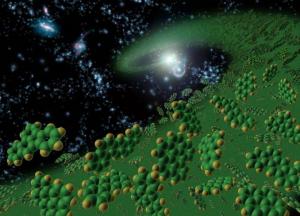Scientists who used Spitzer discovered organic molecules in galaxies that came to us from a time when the universe was only a quarter of its age today

NASA's Spitzer Space Telescope found the essential elements of life at a time when the universe was much younger. Scientists who used Spitzer discovered organic molecules in galaxies that came to us from a time when the universe was only a quarter of its age today.
These large molecules known as polycyclic aromatic hydrocarbons are composed of carbon and hydrogen. Molecules are considered part of the building blocks of life.
These complex molecules are very common on Earth. They are formed whenever carbon-based materials do not burn completely. They can be found in exhaust from car and airplane exhausts, as well as in grilled hamburgers and burnt toast.
These molecules, spread in galaxies like our Milky Way, play an important role in the formation of stars and planets. Spitzer is the first telescope to see these molecules so far down time.
"This is 10 billion years earlier than anything we've seen so far." said Dr. Lin Yan of the Spitzer Science Center at the California Institute of Technology, who was the lead researcher on a study to be published in the Aug. 10 issue of the Astrophysical Journal. Previous missions - the Astronomical Infrared Satellite and the Infrared Space Observatory have detected these types of galaxies and molecules but much closer to our Milky Way.
Spitzer's sensitivity is 100 times greater than previous infrared telescopes and this enables the discovery of such distant organic molecules.
Since the Earth is approximately 4.5 billion years old, this means that these organic materials existed in the universe long before our planet and the solar system formed and may even have been at the core of the solar system's formation.
Spitzer found these organic components in galaxies where a burst of star formation occurred in a short time. These "meat in the pan" galaxies are not visible in visible light because they are very distant and contain large amounts of light-blocking dust. However, the same dust glows brightly in infrared light and is easily observed by Spitzer.
Spitzer's infrared spectrometer splits the light of these galaxies into its components and reveals the presence of organic matter. These organic features give scientists milestones for estimating the distance to these galaxies. This is the first time that scientists have been able to measure a distance as large as ten billion light years from us using the fingerprints of polycrylic aromatic hydrocarbons.
These complex components tell us that by the time we see these galaxies, several generations of stars have already formed." said Dr. George Helou, also from the Spitzer Institute and co-author of the study. "Planets and life were given earliest opportunities to appear in the universe."
